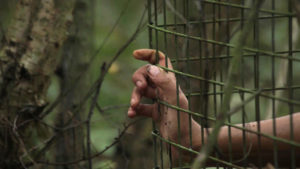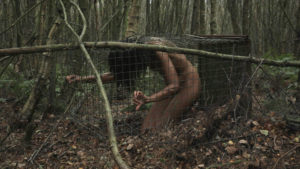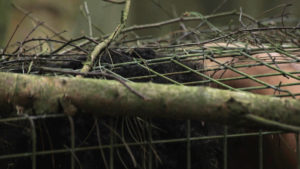- Introduction | Fragments for Borderless futures
- Elena Marchevska | There is no future
- Tara Fatehi Irani | a place to sit
- Syowia Kyambi | Holding Space
- Jade Montserrat | A text on borders dedicated to my Border Terrier (Jack Russell cross), Hilda, who will be one year old on 29 September 2021
- Manuel Vason | urgent images
- Vijay Mathew | How do we increase access and inclusion while powering down civilization?
- Sagar Shah & Jemima Yong | IN CRISIS: GET YOUR COMMS HEAD ON
- contributors + credits
- Download PDF
A text on borders dedicated to my Border Terrier (Jack Russell cross), Hilda, who will be one year old on 29 September 2021.
☀ Jade Montserrat
In November of 2021 I will install myself in Hawick for six months for a residency and commission through Alchemy Film and Arts. Hawick lies on the Scottish Borders and the location will provide stimulus and reference for my intended work there. Not unrelated to this, simultaneously, variations of and the full trilogy of my films Clay, Peat and Cage (2015) will screen in exhibitions at York Art Gallery, GoMA and The Huntarian (both in Glasgow). During email exchanges with GoMA curator Katie Bruce, discussing the context for a potential public event at the gallery and my interest in Corrine Fowler’s book Green Unpleasant Land1, Katie steered me towards a pamphlet by Alice Sage and published by Wide Open Sea titled The Material Legacies of Slavery In The Scottish Borders2. The A4 fold-out booklet comprises eight sides and details a map of the part of the borders that the eleven houses it refers to on the other side of the sheet are situated on. Each property is illustrated by a line drawing, depicting majestic houses.
The three films I refer to above, made in collaboration with film-makers Webb-Ellis, refer to my lived experience of land ownership and the idea of enclosure. My personal desire is to make cages rattle, metaphorically and literally. I commit to advocating for prison abolition, and as an artist who speaks to this within my work as means to expanding my understanding and capacity to speak about it, I have been particularly inspired this past year by Barring Freedom, an exhibition and programme of events at The University of Santa Cruz, Institute of Arts and Sciences, co-curated by a supporter of my work, and now dear friend too, Alexandra Moore. The idea of land enforced borders particularly, and any confining spaces that hinder free movement in general, asks me to consider strategies for peaceful provocation, refusal, civil disobedience, and direct action. Of course, personal boundaries are of vital concern and invert the premise outlined about borders; keep out of my personal space unless permitted to do so. My body, and my hope for bodies the world over, is otherwise an exclusion zone without previous consent.
I believe that my body, everybody, should be free to roam and wander, to work and to love wherever and whenever.
‘Access’ is an imperative for living.

Stills from Cage, Jade Montserrat and Webb-Ellis, 2015, HD video, 4 minutes
In my consideration of borders as a concept, my thoughts turn to Médecins Sans Frontières, translated into English as Doctors Without Borders, an international humanitarian medical non-governmental organisation and a worldwide movement of nearly 65,000 people today, founded in Paris in 1971. As a viewfinder, an organisation such as this helps refine vision and envision futures premised on peaceful solutions to war and atrocity. The people providing medical assistance in this instance confront the opacity and porosity of borders and exemplify charges against exclusion zones.

Stills from Cage, Jade Montserrat and Webb-Ellis, 2015, HD video, 4 minutes
I often return to Adrienne Rich’s sharp short poem Boundary. It suggests the scale of action, that is to boundary as a verb, to boundary something, and in the poem ‘boundarying’ is a calculated loss, a hairsbreadth of agony through division.
For me, this poem also blurs the disciplines of drawing, poetry, and performance: “Here at last I fix a line” is and describes a drawing, and the poem might also be interpreted as score, as witness to divisionary tactics, picturing the cruelty of bureaucratic implementation and hinting towards callous engorgement which is the ownership of lands’ natural issue. Might the delicate yet seething, or is it scathing, line “narrow confines of a sphere” allude to colonialism, for example, and how delineation of the surface of the globe for profit limits abundance? Maybe a starting point for discussions beyond this text, and as a humble legacy of it, is 1948 and Palestine. My thanks to performingborders for commissioning me to write. ☼

Stills from Cage, Jade Montserrat and Webb-Ellis, 2015, HD video, 4 minutes
1Fowler, C. (2020). Green Unpleasant Land: Creative Responses to Rural Britain’s Colonial Connections. Peepal Tree Press Limited.
2Sage, A (2021). The Material Legacies of Slavery in the Scottish Borders. Wide Open Sea